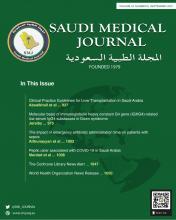To the Editor
I read with interest the article by Dr. Mohammed Aljulifi1 in which he reviewed the prevalence and risk factors of type 2 diabetes mellitus (T2DM) in Gulf Cooperation Council (GCC) countries. The author should be commended for identifying these risk factors, as T2DM prevention is an important and timely topic. However, I believe the role of tobacco smoking as a risk factor for T2DM was underrepresented in the article.
Tobacco smoking is recognized as a significant modifiable risk factor for T2DM, with active smokers at a 30-40% greater risk compared to nonsmokers.2 This increased risk continues for up to 10 years after the cessation of smoking, after which the risk becomes similar to that of nonsmokers.2 Moreover, a recent meta-analysis demonstrated that second hand smoke (SHS) is a risk factor for T2DM among nonsmokers.3 Therefore, when setting health strategies to reduce the burden of T2DM, the prevention and treatment of tobacco smoking ought to be a primary focus.
Smoking as a risk factor for T2DM is of special importance in GCC countries (and Saudi Arabia in particular) for the following reasons:
1) Smoking prevalence: There is a high prevalence of tobacco smoking in GCC countries, with rates continuously increasing since the year 2000.4 The increasing trend in the region does not show signs of slowing, thus emphasizing the need to introduce stronger public health measures.5
2) Secondhand smoking (SHS) prevalence: Although the data on SHS in GCC countries are sparse, several local studies showed a high prevalence of SHS exposure in the population, including among adolescents and children.6 Although regulations to prevent SHS in workplaces and public areas are approved in GCC countries, the implementation of these measures has suffered some setbacks in recent years. For example, catering facilities in Saudi Arabia were recently allowed to maintain dedicated smoking areas, prompting a WHO report that dropped Saudi Arabia from its highest achieving countries.7
3) Smoking among youth: Although the prevalence of tobacco use among adults is important when assessing the magnitude of the current problem, the popularity of tobacco smoking among adolescents is vital to understanding the future burden. Tobacco smoking among boys reaches up to 25% in some GCC countries,8 compared to the 16% global average.5
4) Smoking among women: Until recently, tobacco use in GCC countries has remained low among women. However, this phenomenon is expected to shift in the coming decades. Recent surveys have indicated an increasing rise in tobacco use among women in the region,9 possibly due to changes in cultural perception and gender empowerment. In other countries, tobacco use among women increased in conjunction with empowerment movements.10
5) Waterpipe smoking trend: Waterpipe smoking is increasing worldwide, including in GCC countries, and is especially gaining momentum among women and adolescents,4 potentially leading to an even greater increase in the overall use of tobacco.
6) Smoking and other diseases: Tobacco smoking contributes to several chronic diseases in GCC countries. For example, it was proven that tobacco use accounted for 16.3% of cancer cases in GCC countries (22.8% and 2.8% among men and women, respectively).4 Therefore, efforts to control the tobacco epidemic in GCC countries will simultaneously reduce several diseases.
7) Economic costs: Finally, controlling tobacco will not only save human lives but also can save the GCC countries high economic costs of government-sponsored healthcare and prevention measures, estimated in 2016 to be 34.5 billion international dollars per year.5
Reply from the Author
At the beginning, I would like to thank Dr. Al-Zalabani for his valuable comments. As recommended, smoking is an important issue and should be addressed in each clinical encounter with diabetes patients.11 One study showed that 21.4% of adults in Saudi Arabia are smokers.12 Other study showed that 19.2% of high school female student are smoker in one city of Saudi Arabia.13 It is estimated that 39.3% of male and 3.3% of females in Kuwait are smokers.14 Similar results were found in United Arab Emirates UAE with smoking prevalence of 36% among males and 3% among females.15 In Oman, the prevalence of smoking is expected to be 33.3% by 2025.16 While in Qatar, 21.5% of adults are smokers.17
The relationship between smoking and development of type 2 diabetes (T2DM) is well established. However, the exact mechanism is not fully understood.2,18 It has been found that smoking increases insulin resistance and subsequently, uncontrolled blood sugar.2,19 Also, smoking plays a role in development of microvascular and macrovascular complications of diabetes.1,19 Regarding pregnancy, smoking might be a risk factor for gestational diabetes.2,20
In conclusion, the prevalence of smoking and T2DM are high in Arab Gulf Cooperation Council (GCC) area and the effect of smoking on diabetes prevalence need to be assessed in these communities.
- Copyright: © Saudi Medical Journal
This is an Open Access journal and articles published are distributed under the terms of the Creative Commons Attribution-NonCommercial License (CC BY-NC). Readers may copy, distribute, and display the work for non-commercial purposes with the proper citation of the original work.






